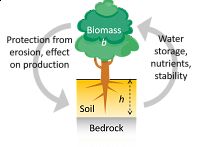Plant-soil feedback
Bistable plant-soil dynamics and biogenic controls on the soil production function
A coupled soil-plant model was developed, exhibiting bistability driven by positive feedback between vegetation and soil.
Model Category: Numerical
Image: Conceptual figure illustrating the feedbacks between soil and vegetation processes.
-
Calhoun, GRAD STUDENT
-
Calhoun, INVESTIGATOR
-
Calhoun, INVESTIGATOR
Soil degradation associated with deforestation, cultivation, and grazing is a major challenge to land management for ecological and agricultural objectives, and the consequences of such human-induced degradation include increased water and wind erosion, changes in soil biogeochemistry, and soil compaction. With respect to soil erosion and biogeochemistry, interactions between soils and vegetation have been implicated as mechanisms causing potentially irreversible loss of soil function. We have developed and analyzed a minimal model of plant-soil dynamics, demonstrating that positive plant-soil feedback underlies the humped soil production function and, therefore, one condition leading to soil depth bistability. The soil and vegetation properties that control transitions between soil-mantled, exposed bedrock, and bistable regions are derived. We also characterize the impacts of vegetation loss associated with agriculture on transitions between fertile and degraded plant-soil states and relate agricultural pressure to soil resilience and catastrophic soil loss.
This model and analysis further generalize previous quantitative work on soil depth dynamics, demonstrating that soil bistability emerges from positive plant-soil feedback that is destabilized by anthropogenic vegetation removal – a critical historical event at the Calhoun CZO. The coupled plant-soil model defines the conditions amenable to bistability: erosion-dominated environments where vegetation is a strong control on soil production. Soil bistability generated by positive plant-soil feedback suggests that changes to the vegetation dynamics can directly cause transitions to degraded states or reduce system resilience to other external perturbations.
In addition to external perturbations, state transitions in the bistable system were found to be induced by changes to the internal vegetation dynamics as characterized by harvest intensity and duration. The bistability which this model examines relates to the multiple stable states hypothesis of the Calhoun CZO, and can be seen as a simple description of the type of system and processes that could cause multiple stable states to arise in coupled human-natural systems such as the CCZO.
Publications
2013
Coupled dynamics of soil formation and erosion in natural and agricultural ecosystems. Pelak, N. F.; Manzoni, S.; Wang, J.; Bras, R. L.; Porporato, A. M. (2013): American Geophysical Union Fall Meeting, December 2013, San Francisco, CA
2016
Bistable plant-soil dynamics and biogenic controls on the soil production function. Pelak, N.F., A.J. Parolari, and A. Porporato (2016): Earth Surface Processes and Landforms 41(8): 1011-1017
Explore Further



